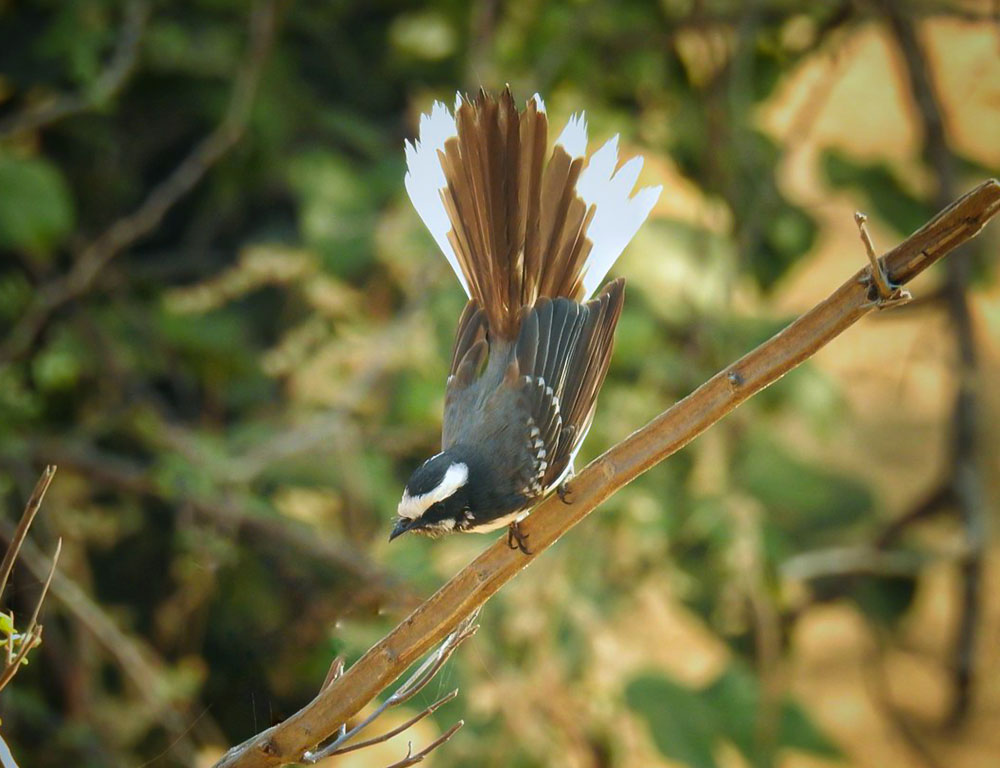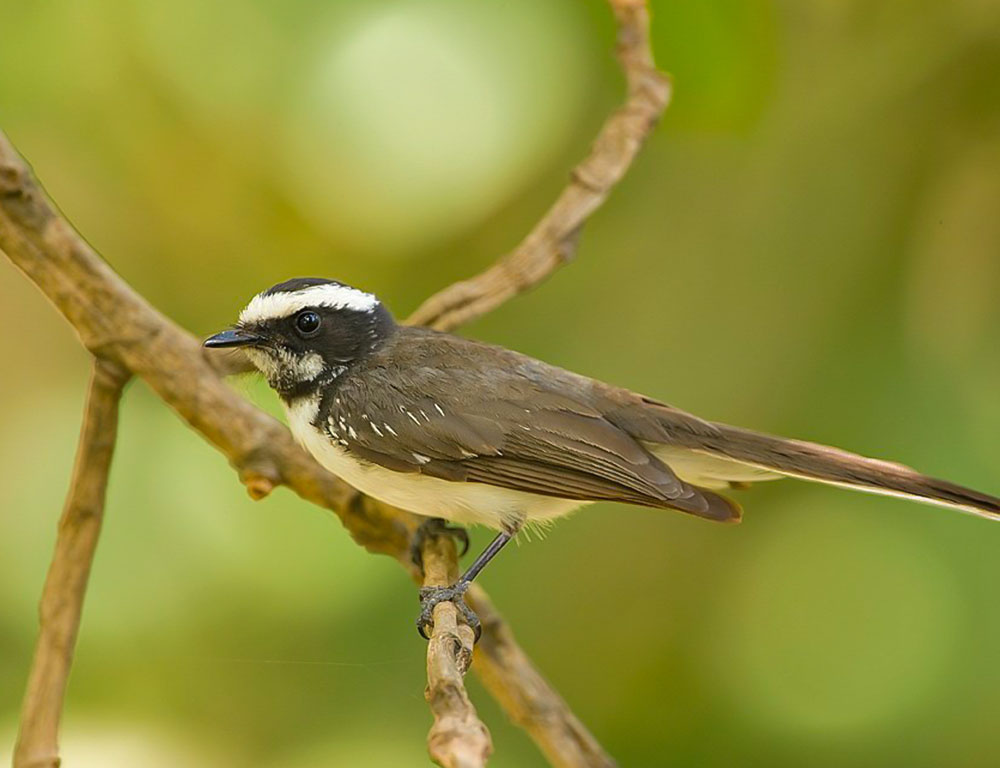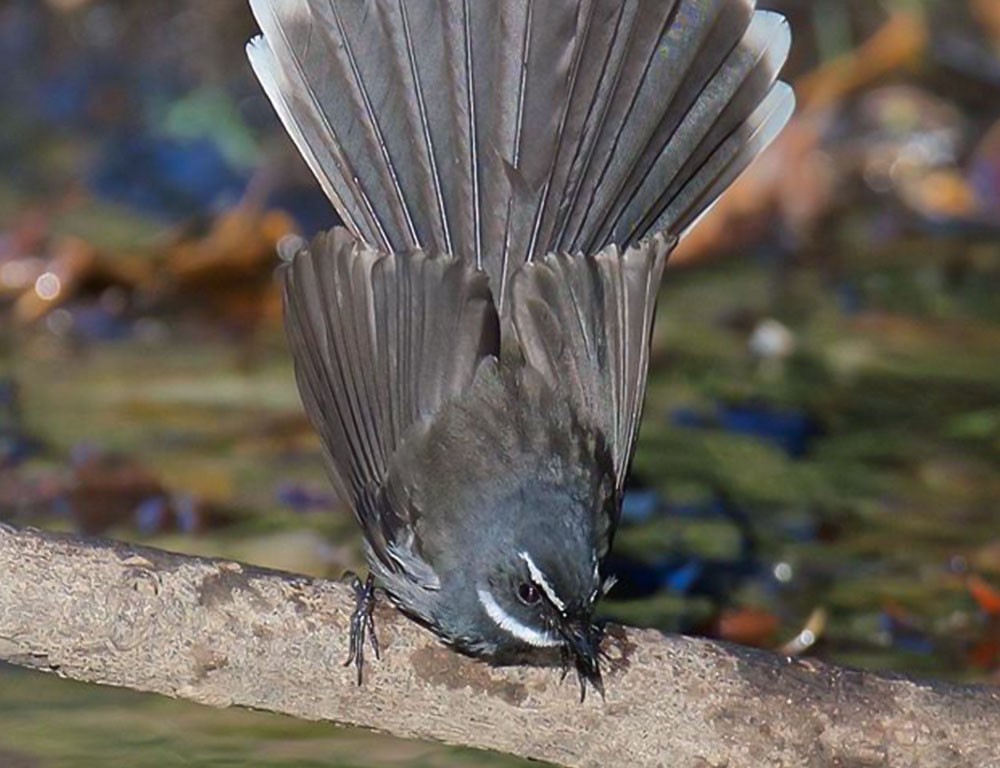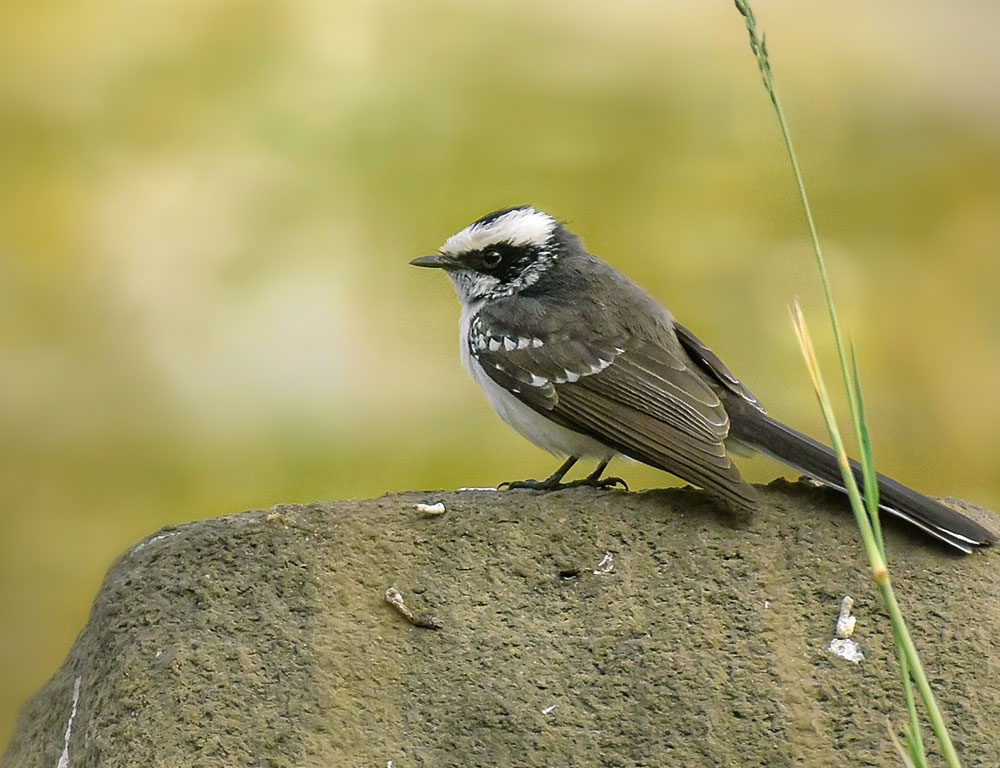Let’s dive into the world of avian wonders and talk about an exotic little bird that’s been captivating birdwatchers and nature enthusiasts – the White-browed Fantail.
With its distinctive features and playful demeanor, this magnificent creature is a sight to behold in its natural habitat.
Native to southern Asia, the White-Browed Fantail is known for its flashy, fan-shaped tail from which it got its name. But what truly sets this bird apart is its striking white eyebrows. These stark contrasts against their dark feathers create a fascinating visage that’s hard to miss.
I’ve spent countless hours observing these birds in their natural habitats, and I can say that their behavior is as enchanting as their appearance. They’re energetic, agile flyers who love to flit around, showing off their spectacular fan-like tails.
Watching them interact in their lively social groups is truly an unforgettable experience.
Physical Characteristics of the White-Browed Fantail

The White-Browed Fantail is a fascinating bird with distinctive physical characteristics contributing to its survival and social behaviors.
Here’s a summary of its critical physical attributes:
Body Length
Typically ranging from 6.7 inches to 7.5 inches, the White-Browed Fantail has a compact body size, allowing it to maneuver easily through dense underbrush.
Weight
Weighing around 0.3 ounces, this bird is lightweight, aiding in its agility during flight and movement through its habitat.
Feather Coloration
The feathers of the White-Browed Fantail predominantly feature a black coloration with accents of white and brown. The wings have darker hues with lighter edges, providing contrast.
White Eyebrows
One of its most distinctive features is the striking pair of white eyebrows that adorn its face, giving it its name.
Fan-Shaped Tail
The tail of the White-Browed Fantail is fan-shaped, consisting of layered feathers that can be spread out during social interactions or hunting. This tail structure aids in balance during flight and serves as an intricate display during courtship rituals.
Wings
The bird has broad wings that enable quick take-offs and agile flight maneuvers, essential for navigating its habitat and capturing prey.
Habitat and Distribution of the White-Browed Fantail

The White-Browed Fantail is a fascinating bird species native to the Indian subcontinent, including regions of India, Nepal, Bangladesh, Bhutan, and Sri Lanka. It’s also found in parts of Myanmar and Thailand.
Here’s a detailed overview of its habitat and distribution:
Geographical Range
The White-Browed Fantail primarily inhabits the lower foothills of the Himalayas. Its distribution extends across various South Asian countries, including India, Nepal, Bangladesh, Bhutan, and Sri Lanka. It’s also found in some areas of Myanmar and Thailand.
Preferred Habitat
These birds prefer warm climates and are typically found in deciduous forests and scrublands. These habitats offer dense undergrowth, providing ample shelter from predators and a rich variety of insects, constituting a significant portion of their diet.
- Deciduous Forests: The leaf-shedding trees in deciduous forests are ideal nesting spots for the White-Browed Fantails. These areas offer both safety and a plentiful food supply.
- Scrublands: Scrubland environments provide excellent hiding spots for these agile flyers. The shrubby vegetation allows them plenty of room to maneuver while pursuing insect meals.
Adaptability
Despite their small size, White-browed Fantails are adept at adapting to different environments. They’ve been observed thriving in cultivated areas and gardens close to human habitation, showcasing their ability to exploit a range of habitats.
Altitude Range
These birds can be found at varying altitudes, from sea level up to altitudes as high as 1300 meters in some instances. This broad altitudinal range reflects their adaptability to different elevations within their habitat.
Human Impact
While the White-browed Fantail demonstrates adaptability, changes in land use, such as deforestation, pose a significant threat to their survival.
Habitat loss and degradation due to human activities can impact their populations over time, highlighting the importance of conservation efforts to preserve their habitats.
Behavior and Diet of the White-Browed Fantail

The White-Browed Fantail exhibits fascinating behavior and dietary habits contributing to its survival in the wild. Here’s a closer look at its behavior and diet:
Activity Pattern
White-browed Fantails are diurnal birds, meaning they are active during the day. They are known for their lively and energetic behavior, constantly flitting around as they search for food or interact socially with other birds.
Boldness and Curiosity
These birds are not shy and approach humans without hesitation, displaying their distinctive white brows and fanned tails. Their boldness can be attributed to their curiosity, as they are always eager to investigate their surroundings.
Diet
The primary diet of White-browed Fantails consists of insects and larvae. They are skilled hunters and employ a hunting technique called ‘hawking’:
- The bird perches in an open area, scanning for potential prey.
- Upon spotting prey, it swiftly takes flight.
- In mid-air, it catches the insect precisely before returning to its perch to consume it.
This hunting technique allows them to capture a variety of insects, such as beetles, flies, moths, and spiders.
During the breeding season, they may supplement their diet with berries or seeds found nearby when feeding their young in nests high up in trees or shrubs.
Adaptability
By observing the behavior and dietary habits of the White-Browed Fantail, we gain insight into its adaptability and survival tactics within its native habitats across Asia, from India through Southeast Asia to Northern Australia.
These birds showcase striking plumage and demonstrate impressive acrobatics while pursuing airborne prey, making them captivating subjects for wildlife enthusiasts.
Conservation Status of the White-Browed Fantail

The conservation status of the White-Browed Fantail, as classified by The International Union for Conservation of Nature (IUCN), is ‘Least Concern’.
While this classification might initially seem concerning, it indicates that the species is not currently facing an immediate risk of extinction.
Here’s why the White-browed Fantail is faring relatively well:
Large Range
White-browed Fantails inhabit a broad geographic area, spanning several countries, including India, Sri Lanka, Bhutan, and Indonesia. This wide distribution contributes to their overall resilience as a species.
Population Stability
Unlike some bird species experiencing rapid population declines due to factors such as habitat loss or hunting, the population of White-Browed Fantails appears to be stable. This stability is an encouraging sign for the species’ long-term survival.
Adaptability
White-browed Fantails can thrive in various habitats, including forests and human-dominated landscapes like gardens and parks. This adaptability enhances their chances of survival in diverse environments.
Despite their current resilience, there are still potential threats that could affect their population in the future:
Habitat Loss
Habitat destruction caused by urbanization, agriculture, and deforestation poses a significant threat to many bird species, including the White-Browed Fantail. Loss of suitable habitat can restrict their ability to find food and reproduce.
Climate Change
Changes in temperature patterns and weather conditions may disrupt the availability of food resources or alter nesting behaviors, affecting the reproductive success of White-browed Fantails.
Conclusion
The White-Browed Fantail is a testament to nature’s resilience and beauty, captivating us with its unique characteristics and adaptive prowess.
As stewards of the environment, we must ensure the preservation of their habitats through responsible eco-tourism and heightened awareness.
By appreciating and safeguarding the diversity of species like the White-Browed Fantail, we not only enrich our understanding of the natural world but also fulfill our duty to protect it for future generations.
May our journey of exploration and admiration for these enchanting birds inspire continued efforts in ornithology and conservation, safeguarding their place in the tapestry of life.